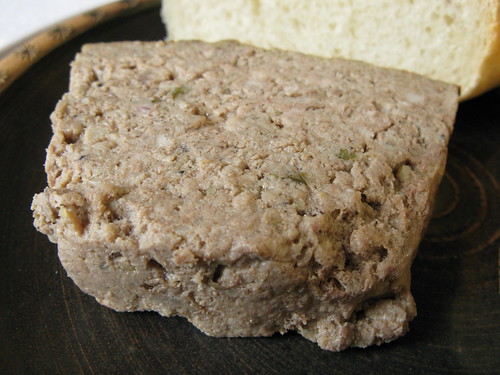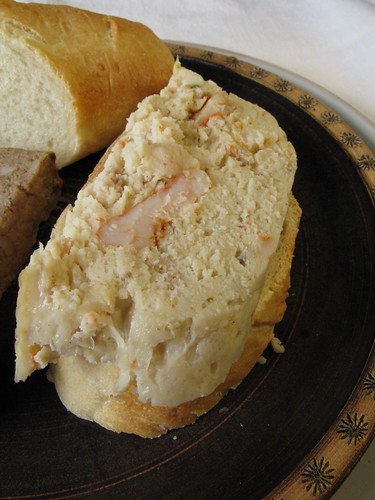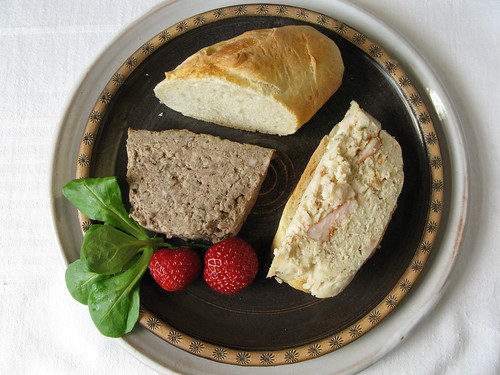Our hostesses this month, Evelyne of Cheap Ethnic Eatz, and Valerie of a The Chocolate Bunny, chose delicious pate with freshly baked bread as their June Daring Cook's challenge! They've provided us with 4 different pate recipes to choose from and are allowing us to go wild with our homemade bread choice.
I liked this month's idea a lot. Some time ago a friend of mine brought a terrine to a party we had and I loved it - of course I nagged my boyfriend to buy me a LeCreuset terrine mould afterwards ... This friend likes to make movies and as he was thiniking about an idea for a new one I told him that I was blogging and that he maybe could make a short film about his cooking adventures which inspired him to make this little masterpiece (of course he chose the terrine I mentioned to be the subject of choice):
I chose to make two different pâtes and the French baguette which was more time consuming than I thought it would be. Thanks to the challenge I now own a porcellain terrine mould which will be used also in the future ...
Chicken Liver Terrine
slightly adapted from Stéphane Reynaud's Terrine

Yields one 25 by 12,5 cm (10 by 5 inch) terrine or loaf pan
- 1 tbsp duck fat, or butter
- 2 onions, coarsely chopped
- 300g (11 oz) chicken livers, trimmed
- 3 tbsp brandy, or any other liqueur (optional)
- 100g (3 1/2 oz, 1/2 cup) smoked bacon, diced
- 300g (11 oz) boneless pork belly, coarsely ground
- 200g (7 oz) boneless pork blade (shoulder), coarsely ground (or ground pork see note below)
- 2 shallots, chopped
- 1 tsp quatre-épices (or 1/4tsp each of ground pepper, cloves, nutmeg and ginger is close enough)
- 2 eggs
- 200 ml (7 fl oz, 3/4 cup + 2 tbsp) heavy cream
- 2 fresh thyme sprigs, chopped
- Salt and pepper
If you cannot find ground pork belly or blade, buy it whole, cut it into chunks, and pulse in the food processor. You can also replace the pork blade with regular ground pork (that is what I did). I don't own a food processor which is strong enough to cut meat, so I used an old meat mincing machine - that is why I got a more coarse result.
Preheat oven to 200ºC (400ºF, Gas Mark 6). Melt the fat or butter in a heavy frying pan over low heat. Add the onions and cook, stirring occasionally, for 5 minutes, until softened. Add the chicken livers and cook, stirring frequently, for about 5 minutes, until browned but still slightly pink on the inside.Remove the pan from heat. Pour in the brandy, light a match and carefully ignite the alcohol to flambé. Wait for the flames to go out on their own, carefully tilting the pan to ensure even flavoring. Set aside. Put the minced pork belly and blade in a food processor, then add the onion-liver mixture and the chopped shallots, and pulse until you obtain a homogenous mixture - make sure not to reduce it to a slurry.Transfer to a bowl, and gradually stir in the chopped bacon, quatre-épices, cream, eggs, and thyme. Season with salt and pepper, and mix well. Spoon the mixture into a terrine or loaf pan, and cover with the terrine lid or with aluminum foil. Prepare a water bath: place the loaf pan in a larger, deep ovenproof dish (such as a brownie pan or a baking dish). Bring some water to a simmer and carefully pour it in the larger dish. The water should reach approximately halfway up the loaf pan. Put the water bath and the loaf pan in the oven, and bake for 2 hours. Uncover and bake for another 30 minutes. The terrine should be cooked through, and you should be able to slice into it with a knife and leave a mark, but it shouldn't be too dry. Refrigerate, as this pâté needs to be served cold. Unmold onto a serving platter, cut into slices, and serve with bread.
Note: This pâté freezes well. Divide it into manageable portions, wrap tightly in plastic film, put in a freezer Ziploc bag, and freeze. Defrost overnight in the fridge before eating. - I made this pâte two weeks ago, ate some and froze the rest - for the pictures I defrostet two slices and they nearly tasted the same compared to the fresh pâte.
Trout and Shrimp Pâté

Yields one 6x3 inch (15x7,5 cm) terrine or loaf pan
- 1 tbsp / 15 ml butter
- 1/4 lb / 4 oz / 120g medium raw shrimp, deveined, shelled and tailed (about 12 medium shrimp)
- 1/8 cup / 30ml Grand Marnier (or cognac, I used Contreau) (optional)
- 1/2 lb / 8 oz / 240g trout filet, skinned and cut into thick chunks
- 1/4 lb / 4 oz / 110g raw shrimp, deveined, shelled and tailed (any size)
- 3/4 cup / 180ml heavy cream
- Salt, to taste
- Green peppercorn, coarsely ground, to taste
- Chives, for garnish
Preheat oven to 375ºF (190ºC). In a heavy, flameproof frying pan, melt the butter over medium-high heat. Sauté the 1/4 pound of medium shrimp, stirring often, until pink and cooked through. Remove the pan from heat. (These shrimp will be used to form layers within your pâté. If you feel they are too thick - you might want to slice them in half lengthwise.) Pour the Grand Marnier over the cooked shrimp. Light a match and carefully ignite the alcohol, to flambé the shrimp. Wait for the flames to go out on their own, carefully tilting the pan to ensure even flavoring. Set aside. Put the trout and the remaining raw shrimp in a food processor and pulse. Gradually pour in the cream and keep pulsing until you obtain a smooth mixture that is easy to spread, but not too liquid (you may not need to use all the cream). Season with salt and green pepper. Butter a 6x3 inch (15x7,5 cm) loaf pan or terrine, then line it with parchment paper. Spoon in half the trout mixture, and spread it evenly. Place the flambéed shrimp on top, in an even layer, reserving 3 or 4 shrimp for decorating. Top with the remaining trout mixture.Prepare a water bath: place the loaf pan in a larger, deep ovenproof dish (such as a brownie pan or a baking dish). Bring some water to a simmer and carefully pour it in the larger dish. The water should reach approximately halfway up the loaf pan. Put the water bath and terrine in the oven, and bake for 35 minutes. The pâté should be cooked through and firm in the center.
Unfortunately I couldn't find ready prepared raw trout filet, so I had to buy whole fishes and filet myself - a little bit disgusting, I don't like my food starring at me ...
French Baguette
from King Arthur Flour

yield: Three 16" baguettes
Starter
- 1/2 cup / 120 ml cool water
- 1/16 teaspoon active dry yeast
- 1 cup / 240 ml flour
- 1 tsp / 5 ml active dry yeast
- 1 cup to 1 1/4 cups / 240 ml to 300 ml lukewarm water
- all of the starter
- 3 1/2 cups / 840 ml flour
- 1 1/2 tsp / 7 ml salt
Make the starter by mixing the yeast with the water, then mixing in the flour to make a soft dough. Cover and let rest at room temperature for about 14 hours; overnight works well. The starter should have risen and become bubbly. Mix active dry yeast with the water and then combine with the starter, flour, and salt. Mix and knead everything together-by hand, mixer or bread machine set on the dough cycle-till you've made a soft, somewhat smooth dough; it should be cohesive, but the surface may still be a bit rough. Knead for about 5 minutes on speed 2 of a stand mixer. Place the dough in a lightly greased medium-size bowl, cover the bowl, and let the dough rise for 3 hours, gently deflating it and turning it over after 1 hour, and then again after 2 hours. Turn the dough out onto a lightly greased work surface. Divide it into three equal pieces. Shape each piece into a rough, slightly flattened oval, cover with greased plastic wrap, and let them rest for 15 minutes. Working with one piece of dough at a time, fold the dough in half lengthwise, and seal the edges with the heel of your hand. Flatten it slightly, and fold and seal again. With the seam-side down, cup your fingers and gently roll the dough into a 15" log. Place the logs seam-side down onto a lightly greased or parchment-lined sheet pan or pans. Cover them with a cover or lightly greased plastic wrap, and allow the loaves to rise till they've become very puffy, about 1 1/2 hours. Towards the end of the rising time, preheat your oven to 450ºF (240ºC). Using a very sharp knife held at about a 45° angle, make three 8" vertical slashes in each baguette. Spritz the baguettes heavily with warm water; this will help them develop a crackly-crisp crust. Bake the baguettes until they're a very deep golden brown, 25 to 30 minutes. Remove them from the oven and cool on a rack. Or, for the very crispiest baguettes, turn off the oven, crack it open about 2", and allow the baguettes to cool in the oven.
Making this takes time. More than I thougt. So if you are planning to bake baguettes, start early. There are lots of videos with recipes at YouTube where you can find several way of making them - the dough always has to rest at some points during the process, just have a look and decide which method suits your routine best.

Today we finally had our French 'lunch' with the two pâtes, the baguette(s) and some fresh salad. I really enjoyed it!

1 Kommentar:
Hmmmm, das sieht nach einem klasse Rezept aus! Bin schon länger auf der Suche nach einem guten Baguette-Rezept, werde das mal testen, vielen Dank!
Kommentar veröffentlichen